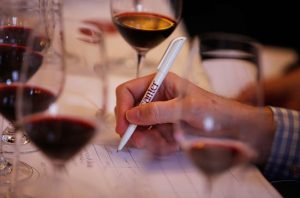
Anson: Tasting note dilemmas
Jane Anson considers the mechanics of putting together a tasting note, and what factors she believes are worth considering.

I’ve been thinking a lot about wine notes recently. Bear in mind that this is the period when I am writing up Bordeaux en primeur wine notes, across Left and Right Banks, plus Sauternes – this year for Decanter Premium – and you can start to see why I might be eating, sleeping and dreaming tasting notes.
As I often find, whether researching for a book or writing up vertical tasting reports, one of the tough things is deciding how much technical information to include.
A tasting note about a finished, bottled wine needs to give an accurate reflection of what someone will find when they pull the cork.
En primeur notes are a different kind of challenge, because here it is not so much about what the wine tastes like today, but what it will become.
That means trying to pick apart the different elements of a young wine that is not even bottled yet, to see if it has the necessary quantity, quality and balance to develop over time, and for how long.
You want to suggest when a wine might be ready to drink, and why.
How to write your own tasting notes – A guide by Andrew Jefford
In both cases, I tend to think that giving a certain amount of technical information is helpful. But not everyone agrees.
Even alcohol is considered unimportant for most American wine reviewers. I had a discussion with a prominent American wine writer about this recently, and he was very clear that his readers were not interested in alcohol levels and didn’t find them helpful to record in his notes.
In fact he believed that it could be extremely unhelpful, because alcohol is perceived differently according to grapes, regions and styles of wine and/or producer – or even, for different tasters, according to the time of day or what food they pair with it.
I can see his point. There are always wines that remind you that you know nothing. Ausone from St-Emilion is one, with its 100% new oak that melts away into its perfect balance. And there’s Pingus from Ribera del Duero, into which 15% alcohol somehow disappears without a trace.
But I still believe that to make an informed judgement on whether to buy a wine, and to anticipate what you are going to find in the bottle, there are certain facts that are helpful. And all those variables mentioned by my American colleague are exactly why providing readers with some technical information is helpful.
We can’t second-guess how people are interpreting our notes, so it is surely useful to give them the tools with which to read and use a review as they need.
A 15% wine enjoyed with supper at home, for example, is a very different proposition to that same wine at a lunch table when you have a meeting immediately afterwards, never mind how perfectly in balance it is. Our role is to do our best to help buyers make informed choices, so in my opinion these things matter.
If a wine is given a rich vanilla flavour though the addition of oak chips rather than barrel ageing, it might not affect enjoyment in the short term, but it will mean its ageing ability is impaired.
And if a wine is brought to balance through manipulation in the cellar (it’s not unheard of to add sugar to increase alcohol and then tartaric acid to freshen things up), it will rarely age as well as one that reached that natural balance in the vineyard.
Not all technical information is useful, and we might not get it right every time. But thinking about these things forces us to look deeper at a wine and its building blocks – and that seems fair not only to the reader, but also to the winemaker who has spent his year working towards its being in bottle.
This column was originally published in Decanter magazine in 2017 and has been updated for Decanter.com.
Jane Anson’s ratings and tasting notes for hundreds of Bordeaux 2017 en primeur wines will be published online exclusively for Decanter Premium members next week
How to join Decanter Premium
The post Anson: Tasting note dilemmas appeared first on Decanter.
